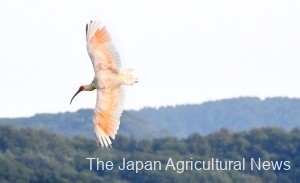NIIGATA, July 3 ― The city of Sado, Niigata Prefecture, was designated as the Globally Important Agricultural Heritage Systems (GIAHS) in 2011, the first such case in Japan, for its satoyama landscape where people coexist with endangered Japanese crested ibis, called toki in Japanese.
During the 12 years after its designation, how did the city manage to spread agriculture that provide nurturing habitats for crested ibis? How can agriculture and economy be balanced with biodiversity?
Many crested ibis can be seen at the Kuninaka Plain, located right in the middle of Sado Island which is shaped like the letter S.
It is a densely inhabited area with paddy fields spreading out, meaning that crested ibis live not deep in the mountains but in satoyama ― villages that live sustainably with their nearby forests and mountains.
A movement to protect crested ibis started in full scale in the 1970s.
The government-supported project to artificially breed crested ibis has been successful, but in order to let the bird live in the wild, it was indispensable to improve the environment of rice paddies ― the habitat for loaches and frogs which the ibis feed on.
In 2001, seven farmers created Sado Toki no Tanbo wo Mamaru Kai, a group to protect rice paddies for crested ibis in Sado.
As the area continued to wane, it was vital for the residents to transform their agriculture to create an environment enabling crested ibis to inhabit and recover the island’s economy.
In 2007, the city launched a system to certify rice that meet requirements including adopting wildlife-friendly farming and using at least 50% fewer pesticides and chemical fertilizers than local practices.
Rice certified under the system, known as the Toki to Kurasu Sato (villages living in harmony with crested ibis) brand, are purchased at higher prices than so-called “specially cultivated rice” made with reduced pesticides and chemical fertilizers.
Currently, out of the total rice acreage in the city, more than 20% are certified rice and 70% are specially cultivated rice.
Along with the spread of such efforts, the number of crested ibis increased, topping 500 in 2022.
To be counted as wildlife-friendly farming, rice farmers need to meet at least one of several factors including creating deep water channels around rice paddies to provide refuge for water dwellers during midseason drainage.
Kunimoto Sasaki, 50, a farmer and sake brewer, scooped handfuls of water from one of the channels and showed some 10 kinds of creatures such as Japanese killfish, crayfish and ferocious water bug, indicating rich biodiversity in the paddies.
Crested ibis are straightforward. They only go to rice paddies where they can feed on. Farmers feel proud to have the bird come flying into their paddies.
One such rice paddy had as many as six crested ibises pecking around on the furrows to feed themselves, then spreading their yellowish-pink toki-colored wings and flying.
Currently, there are roughly 300 rice stores, including those in the metropolitan area, that sell the rice brand.
Sado became widely known nationwide, leading to some 600 people moving to the city a year. Certified rice is offered at school lunches as well.
“Children see the creatures living in rice paddies and learn that rice is not the only thing nurtured in the paddies, which makes them look at farmers and the area in a different way,” said Sasaki, who focuses on food and agriculture education.
The environmental and agricultural revolution that began in the island to protect crested ibis is lightening up the future of the area.


